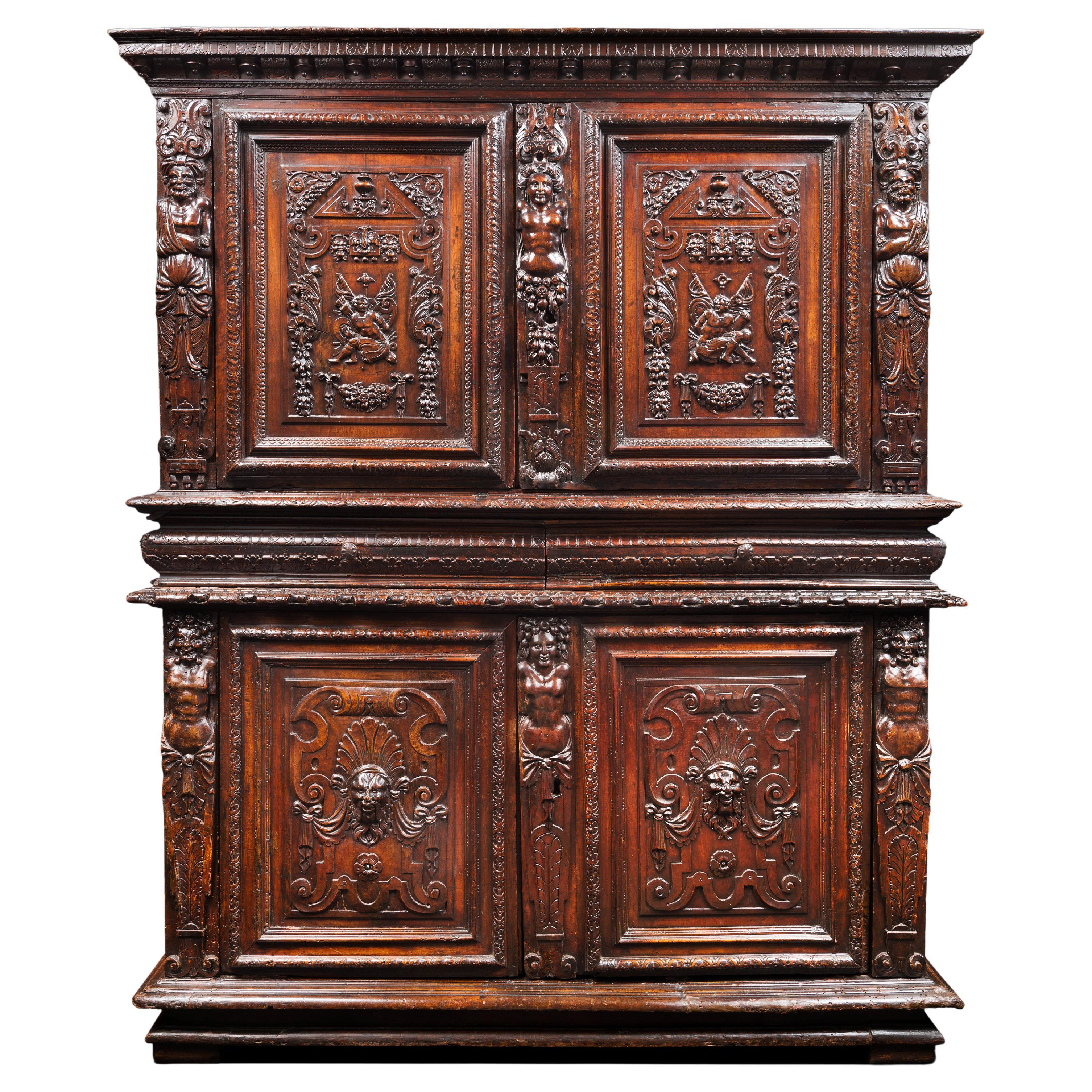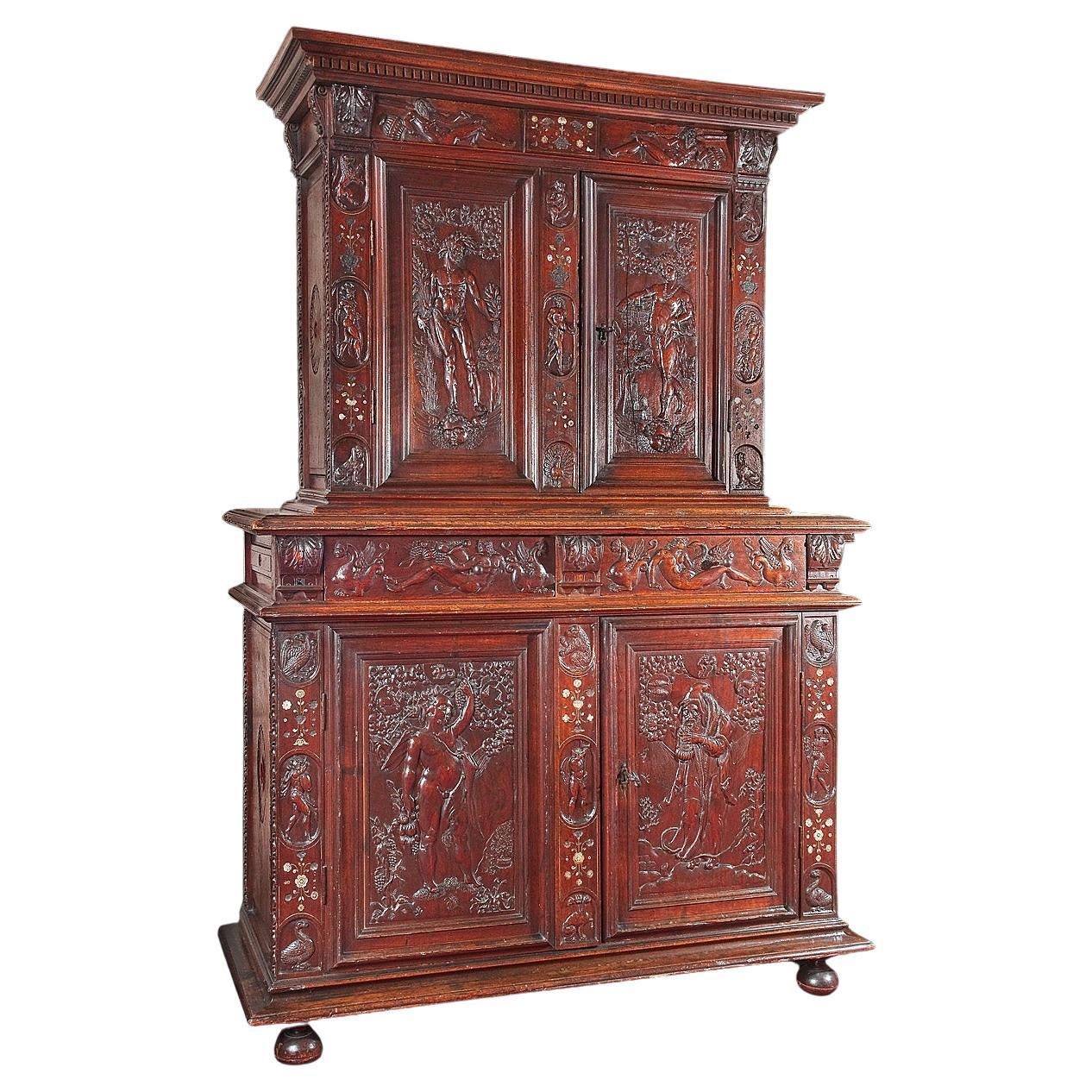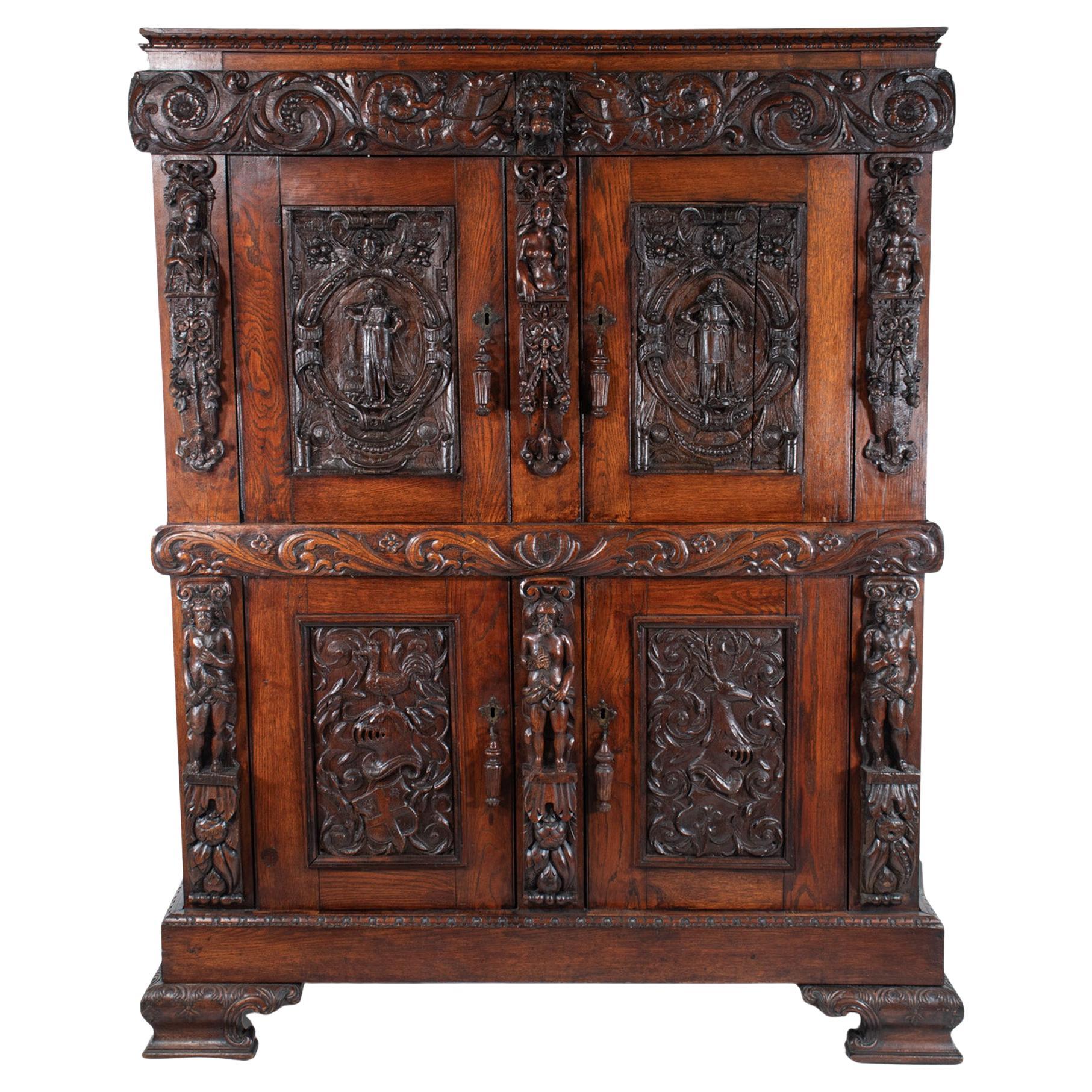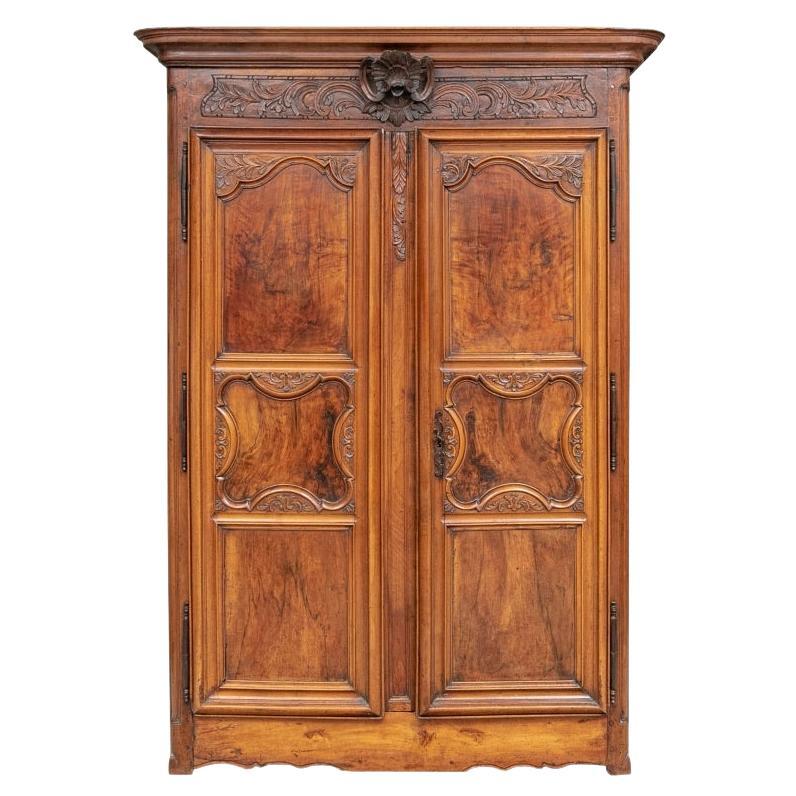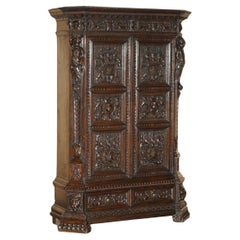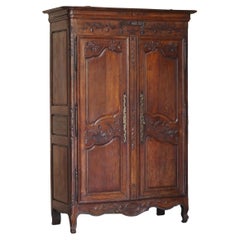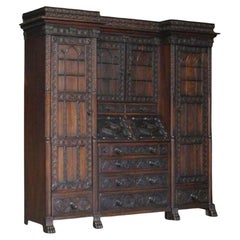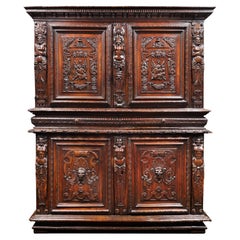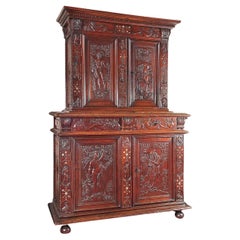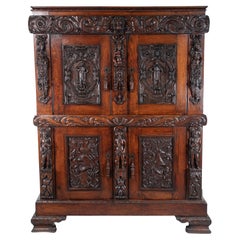Items Similar to Rare Moses Michelangelo Guggenheim & Pauly Cie Et Venice Antique Carved Armoire
Want more images or videos?
Request additional images or videos from the seller
1 of 21
Rare Moses Michelangelo Guggenheim & Pauly Cie Et Venice Antique Carved Armoire
$210,312.46
$350,520.7640% Off
£150,000
£250,00040% Off
€178,224.03
€297,040.0640% Off
CA$287,016.15
CA$478,360.2440% Off
A$319,618.36
A$532,697.2740% Off
CHF 166,343.69
CHF 277,239.4940% Off
MX$3,940,855.87
MX$6,568,093.1240% Off
NOK 2,118,514.20
NOK 3,530,85740% Off
SEK 1,991,197.98
SEK 3,318,663.2940% Off
DKK 1,329,772.44
DKK 2,216,287.4140% Off
Shipping
Retrieving quote...The 1stDibs Promise:
Authenticity Guarantee,
Money-Back Guarantee,
24-Hour Cancellation
About the Item
We are delighted to offer for sale this very rare one of a kind Pauly CIE Et stamped hand carved walnut armoire made by the genius that was Moses Michelangelo Guggenheim 1837-1910
Where to begin, this cabinet is stamped to the rear “Fabrique De Meubles Pauly & Cie Venise. Pauly & Cie” who were a world famous glass foundry and later equally famous furniture manufacturer. Their grotto furniture has an immense following across the world. This piece was most likely retailed through them as it was made by Moses Michelangelo Guggenheim who is a fellow venetian
There is one other known example of his works which is very similar, it is currently retailing for no less than £900,000 however it is accompanied by a few other pieces from a drawing room suite. The suite came from Palazzo Papadopoli, a Renaissance palace on the Grand Canal in Venice built for the Coccini family by Giovanni de Grigi around 1560. I will include some further history below on both Pauly CIE ET and Moses Michelangelo Guggenheium
On to the armoire, it is clearly the most ornate tour de force of carving you will ever see, I’m thankful it has managed to survive so long without being broken up by salvagers looking to reclaim the sculptures. You can see in the carving elements of Pauly’s inspiration in the form of shells. You also have Putti’s riding dolphins and so on. We have fully treated it as there were various signs of old worm, it’s then been cleaned waxed and polished. One of the hidden hinges has been replaced, otherwise it is in near perfect condition for the age. The insides houses three wood shelves
Dimensions
Height 255.5cm top to bottom, without the removable top carving 211cm
Width 170cm arm to arm of the chaps on the outside, 172cm at the top, 166cm at the bottom
Depth 63cm top, 55cm middle, 59cm bottom
Please note all measurements are taken at the widest point
Moses Michelangelo Guggenheim
Leading expert of decorative arts in late 19th century Venice, Michelangelo Guggenheim (1831-1910) also was one of the greatest antiquarians and a modern furniture producer in the “City of Water”. His collections stored in the Balbi Palace on the Grand Canal were an outstanding sight, that art amateurs would recommend.
At the age of 20, he founds a "Stabilimento d’arti decorative e industriali" which purpose is the industrial creation of objects bearing an artistic force. The furniture that made him worldwide famous re-imagines ancient styles, freeing their aesthetic powers to serve modern imagination. Often in walnut, his pieces of furniture sent to World Fairs impress people by the finesse of their sculptures.
A prized designer as well, he reorganizes princely interiors in the same spirit. His most famous work is the Palazzo Papadopoli's design about 1874, where he unfolds the vocabulary of several periods. He conceives there a richly furnished Neo-Renaissance Cabinet that relived the Italian golden age. For the exceptional result he is awarded the Gold Medal of merit for science and arts by Ludwig II of Bavaria.
Pauly & Cie Venise
Since its foundation (1866), Pauly & C. has stood for elegance, creativity and Venetian luxury. The ancient Roman technique known as “murrine”, which today is the symbol of Murano glass, was reproduced for the first time in its workshops and was presented to the world at the Universal Exhibition in Paris in 1878.
In 150 years of business Pauly & C. has produced unique works for royal palaces, public buildings, private villas and has served an international client base that includes some of the most prominent names from the world of culture and art, figures from the world of industry and finance, politicians and nobility.
Pauly & C. - C.V.M. (compagnia Venezia Murano) works are currently held in many private collections and exhibited in some of the most prestigious museums in the world.
In the last years of activity, Pauly has been active with three distinct brands: • Pauly & C. CVM, the time-honoured company that produces classic objects, recreating old designs and collections and offering modern reinterpretations of them. • Pauly Glass Factory, which continues its association with artists and designers to produce artistic works with modern lines. • MVM Interior operates throughout the world with architects, interior designers and design studios for the creation of prestigious personalized projects
History
Compagnia di Venezia e Murano C.V.M. began as Salviati &C. in London in 1866 under the direction of Vicenza attorney Antonio Salviati and with the backing of two British men: archaeologist Austen Henry Layard and antiquarian Sir William Drake.
The company was dedicated to using ancient techniques and utilized master glassblowers in its efforts to do so. It called in specialists from other fields like goldsmithing and engraving to ensure authenticity and employed artist Giuseppe Devers to teach the techniques of enamelling and heat-applied glass gilding to company artisans.
Archaeologist Layard was particularly interested in the mosaic glass techniques of Roman and pre-Roman artists, and he spent years personally overseeing the work of the company's technicians and glassblowers in attempting to revive those techniques. In 1872, the company was successful, managing to replicate the type of glass commonly known as "murrina". The company was renamed Venice and Murano Glass and Mosaic Company Limited in 1872, and, in 1877, Layard purchased Salviati's interest so that Salviati could pursue other interests.
The company quickly earned a reputation for quality original glass art and reproductions as well as its many mural mosaics in Great Britain and elsewhere in Europe. In 1878, the murrine produced by Compagnia di Venezia e Murano was included in its exhibit at the International Exhibition in Paris, which was the chief attraction in Italian glass. In its observations of the display, the United States Commission to the Paris exposition commented not only on "Roman murrine glass", but also particularly on the mural glass mosaics, the "perfection of which" had "engaged the earnest attention of the company." Mosaics produced by the company during the time period are still in existence in diverse areas such as Gonville and Caius College Chapel in Cambridge; St Paul's Within the Walls in Rome, the Victoria and Albert Museum, Westminster Cathedral in London, Old South Church in Boston the Chamberlain Memorial in Birmingham, Palazzo Barbarigo and the Senate House rooms in the United States. The last specimen, a portrait of Abraham Lincoln, was produced and donated in 1866.
Through the last years of the 19th century, Compagnia di Venezia e Murano took part in many other displays. Prior to the 1878 exhibition in Paris, it had shown at the Maritime Exhibition in Naples and the Trieste Exhibition in 1871 and at the International Exhibition in Vienna in 1873, where it won 13 prizes for decorative arts.
It unveiled a new focus in 1881 with the display of the first of its glass phoenixes at the National Exhibition in Milan. It exported several thousand works for display at the World's Columbian Exposition in Chicago in 1893, also setting up a kiln so that the public could observe the company's glass blowing techniques.
In 1895, it exhibited at the first Venice Biennale (an event at which it would also feature later), with artisan Vincenzo Moretti taking prizes and artisan Attilio Spaccarelli earning special note for his engraving. 1900 saw a change in the company when its British owners sold their interest to a businessman from Venice named Tosolini, who was the owner of shops in St. Mark's Square. Under Tosoloni's ownership, the company stopped production in 1909, though it continued commercial distribution at St. Mark's Square.
Merger with Pauly & C Pauly & C was formed in 1903 by Emilio Pauly, Alessandro Hirscber Hellman, Vittorio Emanuele Toldo and Ernesto Graziadei, opening showrooms in Palazzo Trevisan Cappello, which would remain the headquarters of the company until its closure in 2007 for restoration. In 1919, Pauly & C. and Compagnia di Venezia e Murano were both purchased by the Milan Società Anonima Sanitaria, which resold them the following year to Gaetano Ceschina of Milan. The newly merged company, retitled to its present name, continued display in its previous locations of St. Mark's Square and the Palazzo Trevisan Cappello. In 1925, the merged company resumed production of glassworks on Murano and began exhibiting again at the Monza Tirennale.
Post-merger growth and development
The company grew in 1933 with the acquisition of Maestri Vetrai Muranesi Cappellin, or MVM Cappellin, a glass company formed in 1925 by Paolo Venini and Giacomo Cappellin, which transferred to them rights to the works and designs of the MVM Cappellin artists such as Vittorio Zecchin and Carlo Scarpa.
The company expanded into commissioned chandeliers, with notable pieces from the period being placed in such locations as the Palazzo del Quirinale in Rome; the Vatican Palace, and the Royal Palace in Copenhagen. More recently, interior lighting has been designed for such places as the Palazzo Bezzi in Ravenna and the Al Assawi family palace. In 1990, the company again expanded with the acquisition of Toso Vetri d’Arte glassworks.
Transition Ceschina sold his interest in the company in 1963 to the Barbon family, who retained it until 1976, when they sold to Andrea Boscaro. Boscaro owned the company for almost 30 years before 2005. Pauly & C. has ceased its operations in 2016.
Condition
Please view the very detailed pictures as they form part of the description around condition
Please note vintage period and original items such as leather seating will always have natural patina in the form of cracking creasing and wear, we recommend regular waxing to ensure no moisture is lost, also hand dyed leather is not recommended to sit in direct sunlight for prolonged periods of time as it will dry out and fade.
- Creator:Pauly et Cie (Maker),Guggenheim Museum (Maker)
- Dimensions:Height: 100.6 in (255.5 cm)Width: 66.93 in (170 cm)Depth: 24.81 in (63 cm)
- Style:Victorian (Of the Period)
- Materials and Techniques:
- Place of Origin:
- Period:
- Date of Manufacture:19th Century
- Condition:Wear consistent with age and use. Minor fading.
- Seller Location:West Sussex, GB
- Reference Number:1stDibs: LU2823322562612
About the Seller
4.7
Platinum Seller
Premium sellers with a 4.7+ rating and 24-hour response times
Established in 2012
1stDibs seller since 2017
1,984 sales on 1stDibs
Typical response time: 1 hour
- ShippingRetrieving quote...Shipping from: West Sussex, United Kingdom
- Return Policy
Authenticity Guarantee
In the unlikely event there’s an issue with an item’s authenticity, contact us within 1 year for a full refund. DetailsMoney-Back Guarantee
If your item is not as described, is damaged in transit, or does not arrive, contact us within 7 days for a full refund. Details24-Hour Cancellation
You have a 24-hour grace period in which to reconsider your purchase, with no questions asked.Vetted Professional Sellers
Our world-class sellers must adhere to strict standards for service and quality, maintaining the integrity of our listings.Price-Match Guarantee
If you find that a seller listed the same item for a lower price elsewhere, we’ll match it.Trusted Global Delivery
Our best-in-class carrier network provides specialized shipping options worldwide, including custom delivery.More From This Seller
View AllIMPORTANT CARVED NEO RENAiSSANCE ARMORIAL COAT OF ARMS ANTIQUE WARDROBE ARMOIRE
Located in West Sussex, Pulborough
Royal House Antiques
Royal House Antiques is delighted to offer for sale this very rare one of a kind, fully restored, Important Neo Renaissance Armoire Wardrobe hand carved in Fran...
Category
Antique 1840s French Renaissance Wardrobes and Armoires
Materials
Chestnut, Oak
$112,166 Sale Price
20% Off
Antique 1844 Carved & Dated Large Wardrobe Armoire with Expertly Crafted Panels
Located in West Sussex, Pulborough
We are delighted to offer for sale this very grand, hand carved extremely large continental oak wardrobe dated to the base 1844
A truly stunning piece, this is a tour de force of ...
Category
Antique 1840s European Early Victorian Wardrobes and Armoires
Materials
Oak
$7,571 Sale Price
20% Off
Jacobean Revival Antique 1833 Dated Hand Carved English Oak Bureau Bookcase
Located in West Sussex, Pulborough
We are delighted to offer for sale this very rare and highly collectable, ornately carved, 1833 dated Jacobean revival Antique Library Bureau bookcase.
This unit can be dismantled into a few very easy to install pieces, ideal for transport and tricky home installation...
Category
Antique 1830s European Jacobean Bookcases
Materials
Oak
$10,655 Sale Price
20% Off
IMPORTANT CARVED BOOKCASE CABiNET FROM THE BATE COLLECTION IN OXFORD UNIVERSITY
Located in West Sussex, Pulborough
Royal House Antiques
Royal House Antiques is delighted to offer for sale this absolutely exquisite hand carved with Musical instruments, library bookcase cabinet, made for Charles T...
Category
Antique 1830s English William IV Cabinets
Materials
Glass, Oak
$11,216 Sale Price
20% Off
Huge Hand Ornately Carved Antique Victorian Oak Library Bookcase Cupboard Base
Located in West Sussex, Pulborough
We are delighted to offer for sale this very large hand carved Antique Victorian circa 1840-1860 oak library bookcase with ornate scholar carvings
This is a very grand piece of English country...
Category
Antique 1840s English Early Victorian Dressers
Materials
Oak
$13,460 Sale Price
20% Off
VICTORIAN ASH AESTHETIC MOVEMENT WARDROBE BUILT IN CAMPAIGN CHEST OF DRAWERs
Located in West Sussex, Pulborough
Royal House Antiques
Royal House Antiques is delighted to offer for sale this absolutely stunning Antique Victoria Aesthetic Movement Ash wood large triple wardrobe with built in Mi...
Category
Antique 19th Century English Aesthetic Movement Wardrobes and Armoires
Materials
Brass
$5,327 Sale Price
20% Off
You May Also Like
French Renaissance Armoire
Located in Saint-Ouen, FR
Original lock and key
This piece of furniture shows no recess on its upper part. It opens with four folding-doors and two drawers within the belt. The key bears the date 1524 above cross motifs.
Burgundy and Lyon regions subordinated themselves to architecture in a different manner than the other french schools. Rather than using particularly columns and pediments pieces of furniture from Lyon borrow architecture’s organization principles and rigorous designs.
On the upper body a strong feeling of balance and symmetry appears with the folding doors reliefs. Swags of flowers and fruits held with knot cloth centered by a man seating on his arms. Here profiles, masks and chou de Bourgogne mingle with the structuring scrolls. The two lateral terms wear draperies and the goddess Diana in the center wears a belt of fruits similar to Hugue Sambin’s designs (Termes de Diane et de Venus, 1554, BNF).
The two palm-leaves enriched drawers and the alternating scrolls belt balance the weight of the cornice with its alternatings consoles and tops.
The lower body is also adorned by three terms with a feminine one in the center, all three are wearing fruits on their heads. The folding doors are centered upon a motif of cut cuirs by a mask in high relief. Wearing a feathered tiara...
Category
Antique 16th Century French Renaissance Wardrobes and Armoires
Materials
Walnut
$96,291
Impressive Renaissance Revival Armoire
Located in Chicago, IL
This handsome, well-patinated piece hails from Alsace, France. The molded and dentil cornice sits above a cherub-decorated frieze and stepped architrave that is supported by three Cl...
Category
Antique 18th Century French Renaissance Revival Wardrobes and Armoires
Materials
Hardwood
$12,400 Sale Price
20% Off
Rare Renaissance Cabinet Richly Carved
Located in Saint-Ouen, FR
This rare Renaissance cabinet is richly decorated on the doors and drawers with carvings depicting the four seasons, and on the uprights and the entablature, alternating flower bouquets inlaid with mother of pearl. This is a beautifully conceived piece of furniture, representing a crowned portico with its entablature and cornice.
The upper body
Articulated separately in a ternary rhythm, as with the lower body, the upper part opens with two carved doors. The doors are framed by both the lateral uprights and the casing. There are cartouches carved into the casing in which mythological figures are depicted with flower bouquets.
On the doors:
On the right: Spring, a female figure crowned with a wreath of leaves, holding a basket full of flowers. She is wearing necklaces and bracelets on each arm, with drapery discretely wrapped around her body and is standing on a winged putti’s head. On each side are depicted a tree and a village with a steepled church. Above her head floats the three signs of the zodiac corresponding to the season: Aries, Taurus and Gemini.
On the left: Summer, a bearded man crowned with ears of corn and bearing armfuls of corn. He is standing on a similar winged putti, flanked by a tree and an ear of corn. The following three signs of the zodiac appear: Cancer, Leo and Virgo.
On the uprights and the central casing a number of smaller figures seem to represent virtues and vices that newly wedded couples should aspire to and avoid.
On each side, at the bottom of the uprights, there is a dog representing fidelity. Above, a lion embodies power, wisdom, and justice.
In between, on the left upright, there is a figure of noncombatant Athena wearing a helmet and holding a spear, an arrow pointing down and in her left hand, a shield, symbol of protective power. On the right upright, the goddess Venus controls the arrow of Cupid.
The iconography here acts as a clear reminder of the required virtues that both parts of a young couple need to fulfill: fidelity, power, wisdom and justice. For him, the goddess Athena focuses on the power. Whereas for her, it is Venus who shows how to control Cupid’s arrow.
On the central casing at the bottom, by way of contrast, there is a peacock, a symbol of pride and at the top, a monkey representing lust and mischief. In between, a woman holding a chain and a cup full of precious stones while on the floor sits a half empty opened casket. This can be interpreted as a symbol of extravagance.
Above, the entablature, decorated with male figures resting on leaking urns, may symbolize the passing of time. They are flanked by two consoles decorated with acanthus leaves and separated by flower bouquets (inlaid with mother of pearl). Finally on top, a cornice acts as a crown for the piece of furniture.
The lower body
The moulded base stands on four round, flattened feet.
Represented on the doors:
On the left: Autumn, a stocky, naked man crowned with vine leaves, holding fruits in his right hand and with his left, picking a bunch of grapes from a climbing vine. Standing on a mound, he is surrounded by a vine and a hill, at the foot of which a man presses the grapes in a big vat after the harvest. Above the climbing vine appear the signs of Libra, Scorpio and Sagittarius.
On the right: Winter, an elderly man wearing a fur cloak...
Category
Antique 16th Century French Renaissance Cabinets
Materials
Walnut
19th Century French Renaissance Revival Cabinet with Ornamental Figural Carvings
Located in Chicago, IL
This Mid-19th Century French Renaissance Revival oak cabinet showcases a sophisticated combination of two distinct varieties of solid oak, each sourced from different parts of the tr...
Category
Antique Mid-19th Century French Renaissance Revival Wardrobes and Armoires
Materials
Oak
Very Fine and Massive Burled and Carved French Antique Armoire
Located in Bridgeport, CT
A grand traditional French antique armoire in solid cherry wood. The Double Doors with handsome sectioned Burl Panels framed by well-carved Foli...
Category
Antique 19th Century French French Provincial Wardrobes and Armoires
Materials
Cherry
16th Century French Carved Renaissance Cabinet
Located in Saint-Ouen, FR
Rare carved Renaissance cabinet
Period : 2nd half 16th century, ca. 1570
Origin : France, Burgundy or Languedoc
This cabinet embody the produ...
Category
Antique 16th Century French Renaissance Cabinets
Materials
Walnut
More Ways To Browse
Wax Museum
Antique Carved Roman
Antique Hand Saw
Italian Bedroom Suite
Grotto Furniture
Carved Wood Putti
Antique Wood Hand Saws
Gold Italian Display Cabinets
Victorian Shell Art
Guggenheim Sculpture
Salvage Chandelier
Carved Wood Dolphins
Palazzo Murano
Italian Chandelier Gold Wood
Grand Tour Mosaic
Vatican Workshop
Palace Of Westminster
1933 Worlds Fair
